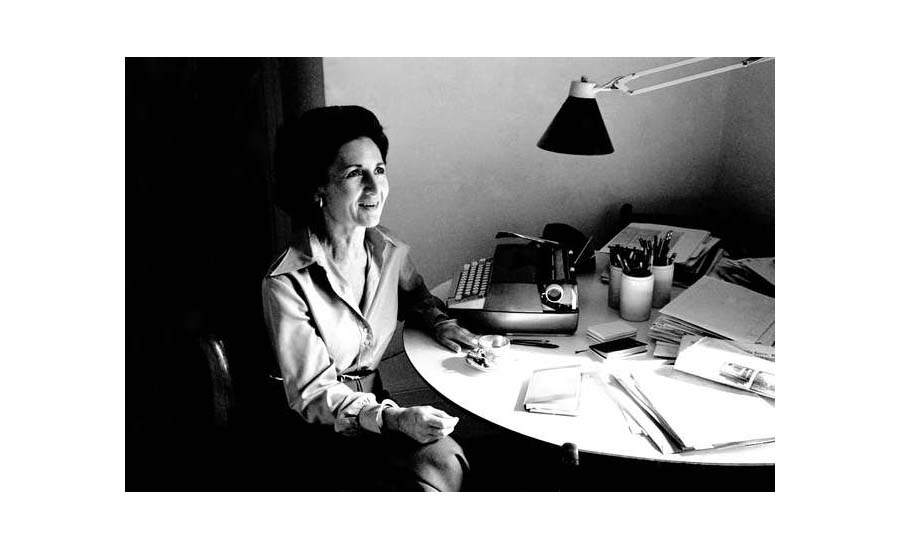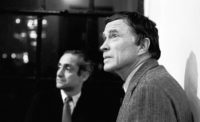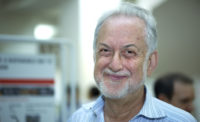Ada Louis Huxtable would have turned 100 on March 14, 2021. When she died in January 2013, we lost the greatest architectural critic of our era, who set a high bar for the design writers who came after her. Here are tributes from some of those she influenced, which RECORD published at the time of her death. (Two of them have died since, Michael Sorkin, and Mildred Schmertz.)
Michael Sorkin
When I was in college, I had a girlfriend who was Ada Louise’s cousin. She’d always promised to introduce me but somehow it never happened. Although we finally met many years later, the regret of that missed opportunity never left me and I’ve always wondered what might have happened had she taken a shine to my own efforts to write about building, helped me along. She was doing something singular and important—bending culture—and I wanted to do something like it. I wanted to be part of that family, her family.
Ada Louise wrote about architecture and cities not as a connoisseur—although her art historian’s eye was fine—but as a citizen and a lover. She was dedicated not to appearances, but to effects, and she wrote with unfailing elegance and conscience from a perspective of wise restraint, judiciously punctuated by both outrage and joy. Her integrity was unassailable and, even now, it’s difficult to list her canon, so judicious was her temperament and technique. One knew what she liked—modernist integrity, the vibrancy of the city, the depths of art, the beautiful synergies of form and life—but her favorites always had to show real merit. Truly, there was never one so passionately fair.
Mildred F. Schmertz
In 1963 Ada Louise Huxtable ceased to be a contributing editor for Progressive Architecture and Art in America because of the immense good luck of being chosen by The New York Times to write a regular column to critically assess what was going on in the fields of architecture and urban design in New York City and everywhere else. No major newspaper in the United States had ever hired anyone to do anything like this. Thereby, she gained and held an audience of the size and significance that her talents deserved. For 19 years her elegant, lucid prose upheld her brilliant and strongly held positions on aesthetic, social, and urban issues. She stepped down from the Times in 1982 at the age of 61, far too soon, but began to write for The Wall Street Journal and The New York Review of Books until shortly before her death.
I was in my sixth year as an associate editor for Architectural Record [ed. note: Mildred became the first female Editor in Chief of Architectural Record] when she first began to appear at some of the architecture events I attended. I always sought her out because I so enjoyed her friendliness and wit. Now that she has gone, it must be said that no journalist in her day wrote about the world of architecture more truly, fairly, and well.
Victoria Newhouse
One of Ada Louise’s most endearing characteristics was her sharp sense of humor. In the course of the many years of architectural discussion I was fortunate enough to enjoy with her, she invariably came up with a bon mot that encapsulated her opinion. An example of this was her description to me of Lincoln Center’s 1960s architecture as “soft modernism.” That witty censure was made in 2009, just as Diller Scofidio + Renfro’s various renovations at Lincoln Center were nearing completion—renovations that I was thinking of including in a book. With her usual generosity of spirit, she suggested we visit the Juilliard School together.
Granted, in 1969 Ada Louise had been less harsh in her criticism of Eero Saarinen’s Vivian Beaumont Theater and Pietro Belluschi’s Juilliard than she was of the Center’s other buildings. But now, standing across Broadway from the school, she went so far as to pronounce the glazed façade that had replaced the school’s stolid masonary front “a miracle from the street.” As on other occasions, Ada Louise went from humor to an inspiring seriousness.
Julie Iovine
Like many a dedicated New Yorker, Ada Louise Huxtable made a seasonal migration out of town. Hers was to Marblehead, MA, and a very modest ranch with a Roman villa's prospect overlooking Salem Harbor. The one-car garage was converted into an office for writing, and around May each year, Ada Louise would start packing up her books and research boxes—most recently for a history of postwar ranch houses—and send them ahead.
Tucked into a bend in the road with barely a path to the front door behind a hedge, the house gave no hint of its glorious site with a screened-in porch and balconies overlooking a steep, terraced backyard with a pool on one level surrounded by deep green, flowering bushes, and a zigzagging path down through pines to the rocky coast.
My two sons and I dropped by every summer in mid-August on our way home to New York from Maine, to deliver a quart of Penobscot Bay blueberries. We arrived last summer around 4, and as always, tea was spread out, with cookies and brownies and ice cream for the boys. Ada Louise sat on the porch and sipped, in a summer white linen version of the elegant grey wool skirt and sweater set she wore in the city. Conversation this year, as in the past, breezed past the delights of coastal living and the latest gardening mishaps back to architecture. I remember the first time Ada Louise used a spirited swear word to describe what some architect had said to her, and my preteen sons jerked to attention.
This summer, in spite of recurring health problems and irritating visits to the doctor that once again had steered her from the book, she was working hard to try to fully understand what the New York Public Library was doing with its planned alterations, and why. Her polite attempts, since at least March, to be given a full description or even a briefing, had been rebuffed stubbornly, even rudely. But she was working around them, studying historical plans, contacting engineers and finding the Landmarks Commission's failure to designate the library's Carrère and Hastings-designed stacks and other interiors an incomprehensible omission. She was elated that a date had finally been set, September 19, for a private viewing of Foster's new plans. Instead, on that date, the library announced an $8 million gift that would allow 3.5 million of the 4.5 million books to stay on the premises in stacks converted from garage space under Bryant Park.
If library officials thought that they could deter Ada Louise, they were mistaken. She plowed on and her excoriating analysis of the developer-driven decision of the library to flip some branches for cash came out on December 3, just about a week after her return to the city from Marblehead. As usual, with a complete grasp of the advantages, the deal-making, the reputations and the hollow promises, Ada Louise cut to the chase, writing: "A research library is a timeless repository of treasures, not a popularity contest measured by head counts, the current arbiter of success. This is already the most democratic of institutions, free and open to all. Democracy and populism seem to have become hopelessly confused." She understood that a city is only as great as the intelligent community it fosters, and her own writings have sharpened our views and expectations of the city that she loved from near and far.
James Russell (@JamesSRussellny)
I am surprised how keenly I feel the blow of Ada Louise Huxtable’s passing. I knew she couldn’t go on forever, but she always seemed as solid as ever. I did not know her well, but email notes from her about my stories suddenly began appearing in my inbox a few years ago. We commiserated on a few issues where she and I were outliers, but I’m sure she found me insufficiently forceful on some issues she was passionate about. I wouldn’t hear from her on those.
I first encountered her writing in the late 1970s, when I moved to New York. Like Lewis Mumford, she didn’t confine herself to questions of style or the historian’s taxonomy. The building was in the city, and the city was always part of the story. I was inspired to write about architecture by her pieces on the big controversies of the day—the tortured future of Times Square, the skyscraper boom of the 1980s, battles over the then-radical idea of historic preservation, and planners’ lame hopes that sad plazas would save a city, which for so long seemed spiraling into oblivion.
She infuriated the hidebound developers who otherwise felt free to inflict their lowest-denominator horrors on the city. I’m sure Times editors fielded countless enraged calls from the cadres who thought they controlled all of the levers of power. Thanks to Ada Louise, they didn’t always.
Robert Campbell
Ada Louise lived in two places. She spent half the year in a high-rise apartment on Park Avenue, which was furnished in part with elegant Modernist pieces by her late husband, the industrial designer Garth Huxtable. The other half, including the summer months, she lived in an ordinary, unpretentious one-story house in the seaside village of Marblehead, Massachusetts, with a view through trees to the harbor. There was no trace of "architecture" about the latter. There she worked, cooked, gardened, entertained guests, and once, a couple of years ago, trapped a woodchuck that was disturbing her plants.
Those two very different dwellings were, for me, a metaphor for the diversity of Ada Louise's taste. With her laser eye for language, she was the first person I'm aware of to point out that the term "authentic reproduction" is an absurd oxymoron. She loved whatever is real, regardless of fashion or the vagaries of taste, and she hated any kind of fakery. Long ago she wrote of how much she liked the "shabby survivals, even the bowdlerized ones, that continue in the mainstream." She continued: "I like pizza parlors and laundromats in Georgian buildings in Lower Manhattan; I deplore putting stoops back on brownstones, taken off for another period's needs and uses, as something prissily artificial that destroys an evolving architecture and a neighborhood's character and charm." Her favorite contemporary architect was James Stirling, the guy who always broke the rules.
Ada Louise spent her last summer in Marblehead working with a couple of research assistants, who were also her neighbors and good friends, digging deep into the architecture of the New York Public Library. She was intensely interested not only in its planning and aesthetics but also its engineering and construction. Doing your homework, she would say. The result was a final landmark article, in The Wall Street Journal, in which she attacked current proposals to revamp the library. As always with Ada Louise, you might agree or disagree, but you never doubted that she knew what she was talking about.
Robert Ivy (@robertivy)
The day after Ada Louise Huxtable died, I found myself in the park before the Plaza Hotel looking toward an urbane New York of ziggurats and plenty, textured open spaces and banal towers, and thought how one person who intensely loved her native city opened this physical landscape to all of us. She peeled back the layers, from kaleidoscopic facades to their social underpinnings. And like the image of justice, she explicated, explained, exposed, and weighed the urban nexus. We valued her judgment because she cared enough to carry us with her through reason and language. For one so tiny (a Park Avenue whirl of femininity), her courageous written voice reverberated like a well-grounded basso profundo. Whether we agreed or disagreed, we always cared what she thought.
Paul Goldberger (@paulgoldberger)
One of my favorite Ada Louise Huxtable lines was never published in The New York Times, or anywhere else. Not long after I became her colleague as the paper’s second architecture critic, she was invited to a meeting on what was referred to, in hushed terms, as The Fourteenth Floor, where the publisher and executives worked. At that point I knew only the messy, disheveled newsroom, where typewriters clacked and carpets were nonexistent. When she returned, I asked her what the exalted space was like.
“High W&J Sloane,” she replied. It was perfect Huxtable—a put-down, yes, to compare the executive suite of the most powerful and sophisticated newspaper in the world to the furniture store that sold fake Sheraton and Chippendale to the haute bourgeoisie of Park Avenue, but a put-down that was elegant and funny and told the entire story in a handful of words. In an instant, she summed up the benign pomposity of that floor, and that, in turn, told me a great deal about what The New York Times was like. She did it in a single phrase.
She knew, of course, that the management of the paper was not visually inclined, and that her editors often knew less about her subject than her readers. And she knew, more importantly, that she would convert them to visual literacy not by lecturing them about their ignorance about architecture and design, but through the strength and clarity of her writing. She was too urbane to be a missionary, and too subtle to be a crusader. She was a writer, and a journalist, and she knew how to trust her own eye, and how to write a good sentence. On that combination, we might say, was the whole modern profession of architecture criticism built, since all of us stand on her shoulders.
Justin Davidson
Sometimes I imagine Ada Louise Huxtable reviewing the Colosseum. I see her prodding the arches, scraping the travertine, rapping the bricks, and then standing back for a comprehensive view. While she goes off to cogitate, senators, engineers, and even the emperor wait around to find out whether they have created a masterpiece of functional elegance or a work of grotesque megalomania. Finally, the tablets are carved: “The first observation one must make about the new stadium is that it is a building,” she has written. “It is not an inflated shack, a gussied-up circus, or a cheap attempt to dress up bloodthirsty entertainment. It is a monument that will come to embody the majesty of Rome.” Phew.
Alexandra Lange (@LangeAlexandra)
Kicked A Building Lately? Well, have you? That question, the title of the 1976 collection of Ada Louise Huxtable’s work for the New York Times, embodies her approach to criticism. It is active, it is irreverent, it is personal, it is physical, and it puts the onus simultaneously on the critic and on her public to pay attention. To kick the tires of a building you have to be present at its creation and its completion. You have to let yourself be small beside it, walk around it, walk up the steps, pick (delicately) at the the joints, run your fingers along the handrail, push open the door. You have to let yourself stand back, across the street, across the highway, across the waterfront, and assess. And then you have to go home and write exactly what you think, in simple language, marking a path through history, politics, aesthetics, and ethics that anyone can follow. I love her writing but the first lesson I teach is that attitude. Architecture is for us, the public, and it is going to get scuffed. (This is an excerpt from Lange's tribute to Huxtable on DesignerObserver.com.)
Carter Wiseman
In 1980, I began a 16-year run as the architecture critic at New York Magazine. My model, of course, was Ada Louise Huxtable. Writing for The New York Times since 1963, she had established herself as the most perceptive, passionate, literate, and incorruptible commentator on the subject. Even more remarkable, she had made such topics as zoning, low-income housing, and floor-area-ratios not just accessible to the lay reader, but also fun to read!
I was fortunate to win some official recognition for my own writing, but none of the framed documents on my office wall mean as much to me as the letter from Ada Louise in response to a piece I had written on midtown construction in New York. It read, in part: “I have never learned to embroider....But if I could, I would embroider a pillow with your immortal summation of air-rights and overbuilding.”
Some weeks later, I was seated on a crowded Lexington Avenue bus and noticed a diminutive older woman overwhelmed by the crush. It was Ada Louise. I parted the crowd and showed her to my seat. As an immortal, she had earned her air rights.
Blair Kamin (@BlairKamin)
She was the best there was. Period. The gold standard, though that flattered gold. Her writing cut through architecture babble with pungent put-downs. The twin towers of the World Trade Center: "the daintiest big buildings in the world." The bloated modern buildings of Washington, D.C.: "the monumental muddle." And, of course, her often-quoted zinger directed at Huntington Hartford's Gallery of Modern Art on New York's Columbus Circle: "a die-cut Venetian palazzo on lollipops."
I once took her to Manny's Cafeteria and Deli, the haimish joint near Chicago's Maxwell Street where mayors rub elbows with beat cops and construction workers. She loved the knife play of the guys who cut the hunks of corned beef. It was an honor to give her a tour of Chicago. And a bigger kick to hear her war stories. Like the time Ed Stone, after being pounded by another of her reviews, asked if something was wrong with her sex life.
Referring to her review of Stone's Columbus Center museum, she kidded that she would always be remembered as "the lollipop lady." I suspect she'll be remembered instead as a fearless trailblazer—the one who set the standards for all the architecture critics who followed; the one who never cowered or followed fashion; the one who celebrated the emergence of the new and championed the preservation of the old; the one who wrote with a soaring intellect and a street-smart wit. I loved her. I'll miss her terribly. Everyone who recognizes that architecture matters should miss her. She was the one who showed it mattered.
Fred Bernstein
In December, this magazine asked me to write about Norman Foster’s plans for remaking the New York Public Library’s Carrère and Hastings building. But a few days before my piece was due, Ada Louise Huxtable published an article on the same project. (It was to be the last time her byline appeared.) Learning of Ada Louise’s article, I panicked. What would be left to say after Ada Louise had offered her opinion? And that was even before I read the piece; after I read it, I knew I would have to struggle to be half as cogent.
A critic hopes to produce significant work at 31 or 51, but Ada Louise was exactly as good at 91, writing about the Public Library proposal, as when she took the reins at the New York Times in 1963. I began reading her as a child in the 1960s. (My mother was an architecture buff and she spoke the name Ada Louise Huxtable as if she were invoking a deity.) Ada Louise’s last piece, which made a powerful case against the library’s plans, included a rare bit of impatience. (She noted that the library had, despite repeated promises, failed to provide her with renderings, but that she would wait no longer to offer her opinion.) Did she know she was dying, and decide to publish without seeing the renderings, knowing her voice, more than any other, could save the Public Library from what she believed to be its self-destruction?
I’m sure every writer who has covered the same territory as Ada Louise has felt the panic I felt: What’s left to say after the greatest critic has said what needs to be said, in such elegant prose? But no one ever begrudged Ada Louise her enormous gifts, because she used them so very wisely, right up to the end.







Post a comment to this article
Report Abusive Comment